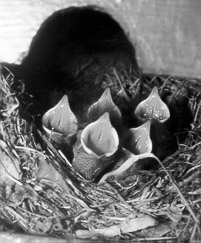The Robin in Ireland
The Robin is one of Ireland’s most common and best loved songbirds. The image of a Robin perched on a snowy bough is particularly associated with Christmas time. For the past three years I have been studying the breeding and wintering habits of Robins in Ireland as part of my PhD in U.C.C.

There can be very few people in this country who aren’t familiar with the Robin’s song. There must be even fewer who couldn’t recognise the bird. There is an enormous amount of folklore and superstition attached to the Robin. Many people associate them with fire or even death, while the more optimistic among us see them as a sign of good luck.

Robins are short-lived birds. Most will live much less than two years. Like many animals juvenile mortality is very high. Even adults have many natural enemies. My study has shown that two of the major culprits are cats and cars! Robins pair up for the breeding season in Winter or early Spring and nest building can begin as early as February. The robin may rear 2-3 broods in a single season and generally a new nest is built for every clutch. Incubation takes about two weeks and the chicks will remain in the nest for a further fortnight. In the nest they are fed regularly, and usually by both parents. They choose a wide variety of nest sites. During my study I observed nests in very unusual places! In 1998, and again this year, a family near Foynes, Co Limerick, had a Robin nesting in their living room. On both occasions the adult birds calmly flew in and out through an open window, apparently unconcerned by the television, children playing and general hubbub. Happily all the chicks made it safely outside, after spending a few hours finding their bearings on the family sofa!
The best estimate of the number of Robins in Ireland would be in the region of 3-4 million! They are present and abundant in almost every type of habitat. While many bird species appear to be in decline, both here and in Britain, it seems that the Robin is still thriving. The reason for this continued success probably lies in its adaptable nature. In all respects the Robin is a generalist and whether it is foraging for earthworms in recently turned soil, or stealing food from the dog’s bowl, this is a bird that has learned to reap the benefits of living close to man. It is perhaps surprising then that very little information has ever been collected on Irish Robins.
My project has centred on the breeding habits of Robins in Ireland. I enrolled people from all over Ireland to make observations at Robins’ nests. These details were recorded on a special “Robin Nest & Habitat Study” card. Thousands of volunteers took part in monitoring around 800 nests. The data collected will help generate a national (and regional) picture of the nesting habits of Robins in this country. For instance, the average number of eggs laid (4.6) is lower than in Britain, but it seems that more chicks survive to fledge in Ireland. Questions such as: do rural nests get predated more than suburban nests?, are nests early in the Spring more successful than later nests? etc. may all be answered thanks to the efforts of the participants.
Robins are very territorial – during the Breeding season the pair will share and defend a common territory against all other Robins. Usually this involves no more than a few notes of song, although occasionally the trouble will escalate. This can appear quite comical with some serious ‘shaping’ before any blows are struck. The red breast is used in these cases as a warning the intruder being shown the breast as the belligerent territory owner literally dances a furious jig about the intruder. The fact that Robins are faithful to a particular area allows you to estimate how many territories there are at a given site. In fact many Robins will live and die within sight of their birthplace. In stark contrast is the situation where a small minority will migrate during the Autumn and return in the early Spring. By ringing (tagging) birds with leg bands carrying a unique code enthusiasts have tracked the movements of individual birds from place to place. Bird ringing allows us to understand where Swallows migrate to and it has also given us an insight into how some birds that were always thought to be resident can in fact venture south for a sunnier Christmas. Looking at every woebegone Robin on your Christmas Cards it may be easy to understand why!